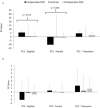Hip Joint Kinematic Covariation During Gait Before and 1-Year After Hip Arthroscopic Surgery for Femoroacetabular Impingement Syndrome
- PMID: 34485370
- PMCID: PMC8416035
- DOI: 10.3389/fsurg.2021.614329
Hip Joint Kinematic Covariation During Gait Before and 1-Year After Hip Arthroscopic Surgery for Femoroacetabular Impingement Syndrome
Abstract
The primary aim of this study was to determine if the three-dimensional (3D) hip joint motion coordination during gait changes after arthroscopic surgery for femoroacetabular impingement syndrome (FAIS). Three-dimensional hip joint kinematic data were collected with a 12-camera motion capture system. Five trials of level walking were collected preoperatively (PRE) and at 1-year postoperatively (POST) in 8 patients diagnosed with FAIS and at a single time point in 8 healthy controls. Planar covariation analysis was performed to quantify the 3D hip joint motion coordination strategy during gait. Independent sample's t-test were used to determine differences between the FAIS group at the preoperative time point (PRE) and healthy controls. Paired samples t-tests were used to determine differences between the PRE and POST time points within the FAIS group. The %VAF by PC 1 for the FAIS group at the PRE time point was significantly less than that of healthy controls (PRE: 77.2 ± 8.7% vs. Control: 96.1 ± 2.8%; p = 0.0001), and the % VAF of the second PC (PC2) was significantly greater [PRE: 22.8 (8.7)%; Control: 3.9 (2.8)%; p = 0.0001]. No differences in %VAF were found between the PRE and POST time points within the FAIS group for PC1 [PRE: 77.2 (8.7)% vs. POST: 79.3 (11.1)%; p = 0.472] or PC2 [PRE: 22.7 (8.7)%; POST: 20.7 (11.1)%; p = 0.472]. Significant differences in the plane specific contribution to the 3D motion coordination strategy were found between the FAIS patients at the PRE and POST time points for the sagittal plane [PRE: 5.6 (2.7) vs. POST: 0.91 (6.1); p = 0.012] and frontal plane [PRE: -10.4 (2.2) and -1.5 (6.3); p = 0.005]. Patients with FAIS demonstrated a more complex coordination strategy of 3D hip joint motion than controls and this strategy remains unchanged after hip arthroscopic surgery despite changes in the plane specific contribution to this strategy. These findings indicate that motor control impairments in FAIS patients do exist and seem to persist for at least 1 year after hip arthroscopic surgery.
Keywords: biomechanics; femoroacetabular impingement syndrome; gait analysis; hip; kinematic covariation.
Copyright © 2021 Malloy, Dr. Neumann, Leung and Kipp.
Conflict of interest statement
The authors declare that the research was conducted in the absence of any commercial or financial relationships that could be construed as a potential conflict of interest.
Figures


Similar articles
-
Squat and gait biomechanics 6 months following hip arthroscopy for femoroacetabular impingement syndrome.J Hip Preserv Surg. 2020 Feb 18;7(1):27-37. doi: 10.1093/jhps/hnaa004. eCollection 2020 Jan. J Hip Preserv Surg. 2020. PMID: 32382426 Free PMC article.
-
Impaired Lower Extremity Biomechanics, Hip External Rotation Muscle Weakness, and Proximal Femoral Morphology Predict Impaired Single-Leg Squat Performance in People With FAI Syndrome.Am J Sports Med. 2021 Sep;49(11):2984-2993. doi: 10.1177/03635465211029032. Epub 2021 Aug 2. Am J Sports Med. 2021. PMID: 34339327
-
Three-dimensional lower limb kinematics and kinetics in femoroacetabular impingement syndrome (FAIS) patients with and without borderline developmental dysplasia of the hip (BDDH) during level walking.BMC Musculoskelet Disord. 2025 May 16;26(1):488. doi: 10.1186/s12891-025-08727-4. BMC Musculoskelet Disord. 2025. PMID: 40380344 Free PMC article.
-
Predicting Outcomes in Hip Arthroscopy for Femoroacetabular Impingement Syndrome.Curr Rev Musculoskelet Med. 2024 Mar;17(3):59-67. doi: 10.1007/s12178-023-09880-w. Epub 2024 Jan 6. Curr Rev Musculoskelet Med. 2024. PMID: 38182802 Free PMC article. Review.
-
Cutting, Impingement, Contact, Endurance, Flexibility, and Asymmetric/Overhead Sports: Is There a Difference in Return-to-Sport Rate After Arthroscopic Femoroacetabular Impingement Surgery? A Systematic Review and Meta-analysis.Am J Sports Med. 2021 Apr;49(5):1363-1371. doi: 10.1177/0363546520950441. Epub 2020 Sep 10. Am J Sports Med. 2021. PMID: 32909823
Cited by
-
Hip and Pelvis Movement Patterns in Patients With Femoroacetabular Impingement Syndrome Differ From Controls and Change After Hip Arthroscopy During a Step-Down Pivot-Turn Task.Orthop J Sports Med. 2024 Feb 8;12(2):23259671231169200. doi: 10.1177/23259671231169200. eCollection 2024 Feb. Orthop J Sports Med. 2024. PMID: 38361996 Free PMC article.
-
Changes in physical impairments in femoroacetabular impingement syndrome following arthroscopic surgery: a systematic review and meta-analysis.J Hip Preserv Surg. 2025 Jan 22;12(2):105-117. doi: 10.1093/jhps/hnaf002. eCollection 2025 Jul. J Hip Preserv Surg. 2025. PMID: 40761575 Free PMC article.
References
LinkOut - more resources
Full Text Sources
Research Materials
Miscellaneous

